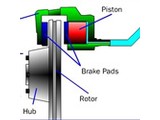Bed-In procedure for EBC Brake Pads.
MINI recommends NEW rotors when installing new brake pads. MINI factory does not recommend 'Turning' of MINI rotors.
We recommend the use of 'anti-squeal' compound, even though EBC uses anti-vibration shims on all their pads.
Brake Fluid should be changed/flushed every two year.
Use caution when driving immediately after installing new pads - brake efficiency, noise, and dusting will not be optimal until the pads are 'broken in'. As the Pads are broken in, brake feel will improve, any 'squealing' noises will diminish, and the amount of brake dust will be reduced.
EBC BRAKE PADS BED-IN PROCEDURE:
- Use brakes with minimal pressure for first 100 miles from urban speeds of 30-50 mph only. Brakes will feel very sharp and responsive but this is ONLY the brake in coating working which gives an abnormally high friction level feeling.
- Drive a further 250 miles using slightly increased brake pressure and load UNLESS in an emergency in which case apply brake as hard as required.
- Clean wheels off as there will be residue from the brake-in coating after bed in.
- Look for a full width contact across the pad depth( rotor braking band) from the outer edge of the disc to the inner and if not achieved allow a further 100-200 miles steady driving. You will see a blue-ish band evidencing contact across the rotor face. Until this band goes from the outer to the inner edges of the brake disc/rotor the pads have NOT yet fully seated. When installing new rotors, reduced width banding is quite possible due to various tolerances and slight misalignments in the vehicle chassis and is NOT a warranty defect or a reason to remove and inspect brakes. Many European cars have SINGLE PISTON CALIPERS and these tend to “Flair” open and cause the contact band described above only to be seen at the outer edge of the disc/rotor and work its way inwards taking up to 1000 miles to do so.
- After full width contact band is attained make a further 10 stops from 60 mph to 10 mph in succession with a deliberate attempt to get the brakes hot. Some smells may occur even slight smoke during this final heat up stage of the pads in early life. Then coast the vehicle for a mile to allow discs to cool. Do not pull up and park vehicle with brake excessively hot. You must try to get the discs down to below 60-80 degrees C temperature before parking the vehicle.
- When parked let brakes cool to a final cool-to-touch point. Before touching discs splash a few tiny drops of water onto the disc to asses its temperature to avoid burning fingers. If the water spots cause a “hiss” you have parked up too soon and should go out and drive slowly allowing the brakes to cool further.
NEW DISCS TAKE LONGER TO BED IN
Fully bedding new pads to decent condition worn discs/rotors may take only 200-300 miles but when new discs are fitted at the same time bed in times to achieve outer to inner edge contact ( full width blue-grey contact band as mentioned under point 4 above ) can be as long as 800-1000 miles due to extra components needed to be aligned to the vehicle. To Short cut this you can ( and EBC recommend should) have EVEN NEW DISCS Pro Cut Lathe aligned to your vehicle. This process removes only microns of new disc material and shortens bed in time by 75% of the time it COULD take giving you better brakes faster and avoiding hot spotting and pad glazing.
BADLY WORN DISCS/ROTORS CAN TAKE AN AGE TO BED IN
Discs/Rotors with more than 0.5 mm ( 0.020 inches) of lip at the outer edge or hollow in the centre of the braking area can take up to 2000 miles to bed in and will for sure cause Noise, brake fade,vibration and pad burning. Bad rotors can RUIN your pads. 95% of brake fade and noise complaints come from poor disc/rotor condition where the pads touch only at the outer and inner edges and have no chance to deliver an effective brake.









